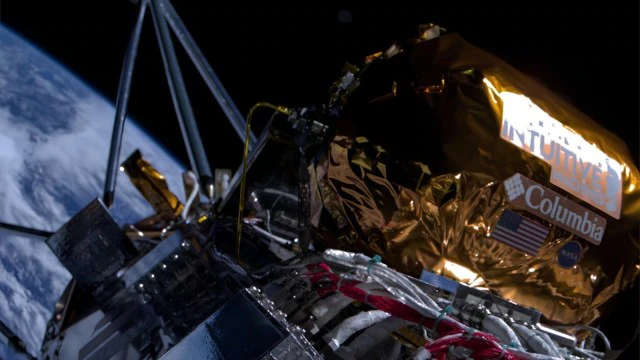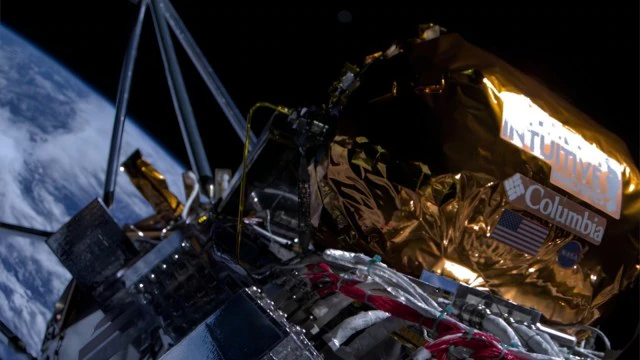The confirmation of the landing came a day after the spacecraft entered lunar orbit, and a week following its launch from Florida. Signals were successfully beamed back over a distance of approximately 239,000 miles (384,000 km) to mission control.
Odysseus, a spacecraft constructed and launched by the Texas-based company Intuitive Machines, successfully landed near the moon’s south pole on Thursday. This historic event marks the first U.S. touchdown on the lunar surface in over half a century and represents the inaugural achievement solely accomplished by the private sector.
The six-legged robot lander, also named Odysseus, made its touchdown at approximately 6:23 p.m. EST (2323 GMT), as reported by the company and NASA commentators in a collaborative webcast from Intuitive Machines’ mission operations center in Houston.
As per the plan, the spacecraft was anticipated to settle at a crater known as Malapert A near the moon’s south pole, as indicated in the webcast.
The confirmation of the landing came one day after the spacecraft entered lunar orbit and a week following its launch from Florida. Signals, transmitted over a distance of approximately 239,000 miles (384,000 km) to mission control, verified the successful landing.
However, communication with the vehicle took several minutes to re-establish, and the initial signal was faint. This left mission control in a state of uncertainty regarding the precise condition and position of the lander, as reported by flight controllers in the webcast.
The spacecraft was not designed to provide live video of the event.
The touchdown occurred after a last-minute glitch with the spacecraft’s autonomous navigation system, prompting ground engineers to implement a workaround solution.
Loaded with a suite of scientific instruments and technology demonstrations for NASA and various commercial customers, the vehicle is designed to operate for seven days on solar energy before sunset over the polar landing site.
The NASA payload aims to gather data on space weather interactions with the moon’s surface, radio astronomy, and other aspects of the lunar environment. This information will be valuable for future landers and NASA’s planned return of astronauts later in the decade.
Launched on Wednesday aboard a Falcon 9 rocket from SpaceX, Elon Musk’s company, at NASA’s Kennedy Space Center in Cape Canaveral, Florida, the uncrewed IM-1 mission marked the first controlled descent to the lunar surface by a U.S. spacecraft since Apollo 17 in 1972, NASA’s last crewed moon mission with astronauts Gene Cernan and Harrison Schmitt.
Up to now, only spacecraft from four other countries—the former Soviet Union, China, India, and Japan most recently—have landed on the moon. The United States remains the sole country to have sent humans to the lunar surface.
DAWN OF ARTEMIS (Odysseus Spacecraft)

Odysseus’s arrival signifies not only the first “soft landing” on the moon by a commercially manufactured and operated vehicle but also the initial one under NASA’s Artemis lunar program. This milestone comes as the U.S. races to return astronauts to the moon ahead of China’s crewed spacecraft landing.
NASA’s Artemis program targets a crewed lunar landing in late 2026, playing a crucial role in sustained lunar exploration and serving as a stepping stone for future human flights to Mars. The emphasis on the moon’s south pole is due to the presumed abundance of frozen water, a valuable resource for life support and rocket fuel production.
Under NASA’s Commercial Lunar Payload Services (CLPS) program, numerous small landers, including Odysseus, are expected to pave the way. This initiative is designed to deliver instruments and hardware to the moon at a more cost-effective rate compared to the traditional method of building and launching vehicles by the U.S. space agency itself.
Relying more on smaller and less experienced private ventures carries inherent risks. In the previous month, Astrobotic Technology, another company, faced a propulsion system leak with its lunar lander shortly after being placed in orbit on January 8 by a United Launch Alliance (ULA) Vulcan rocket on its maiden flight.
The malfunction of Astrobotic’s Peregrine lander marked the third instance of a private company failing to achieve a successful lunar touchdown, following unsuccessful attempts by companies in Israel and Japan.
While Odysseus takes the spotlight in NASA’s CLPS program, the IM-1 flight is attributed to Intuitive Machines as its mission. The company was co-founded in 2013 by Stephen Altemus, the former deputy director of NASA’s Johnson Space Center in Houston, who currently serves as the company’s president and CEO.
The surge in commercial space ventures is a result of significant technological advancements in recent decades. The Apollo program and the preceding robot lunar Surveyor missions operated during the early stages of the computer age, predating modern microchips, electronic sensors, software developments, and the creation of lightweight metal alloys, among numerous other innovations that have sparked a transformative revolution in spaceflight.
